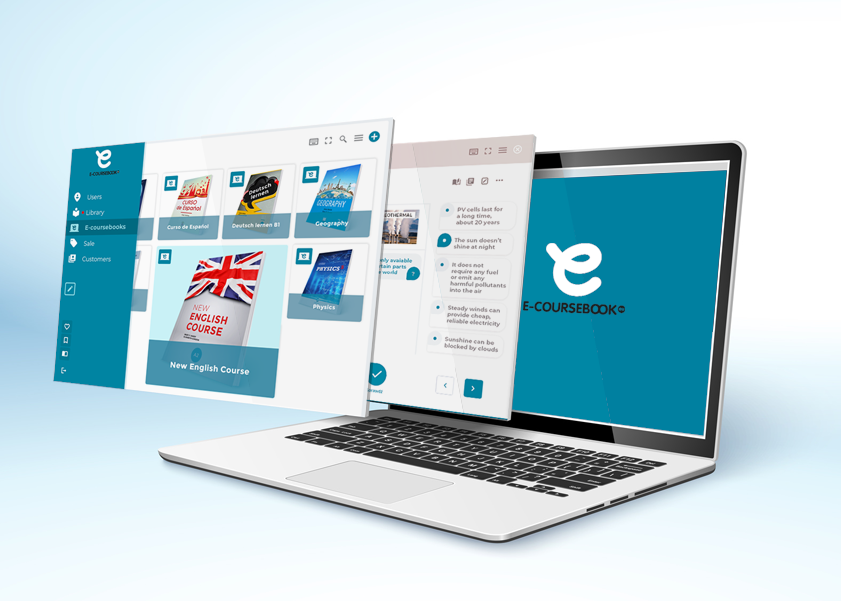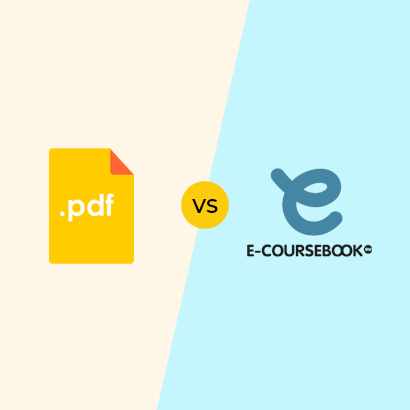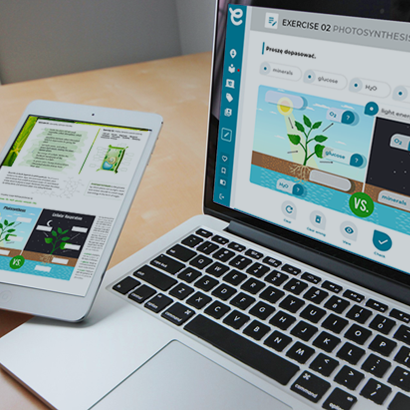Are digital textbooks the answer to the challenges faced by educational publishing houses?
Reading time



6 minutes
Recent years have shown quite clearly that businesses involved in the sales of educational products are facing enormous challenges. Changes in the teaching system and the unexpected and dynamically changing situation related to the pandemic have shown that the publishing market is far from being stable. In order to maintain and strengthen its position in the market, each publishing house must skillfully focus its efforts on innovations that will effectively influence its development. Are digital textbooks a necessity, just an additional distinguishing feature of the offer, or perhaps merely a temporary fad dictated by the restrictions related to the pandemic? Let's take a closer look at this issue.
Educational materials and textbooks, and their digital reality
Media solutions have been growing in popularity for years now, especially for language learning and specialist courses. Restrictions implemented to prevent the spread of COVID-19 have made remote learning commonplace. Teachers, lecturers, and textbook publishers faced the challenge of adapting to the current conditions so that pupils and students could best find themselves in this situation and so that the quality of education wouldn’t deteriorate. The teaching staff and the learners adapted to the conditions as best they could [1], but the publishing market wasn’t prepared for such a black swan event.
Naturally, there was no shortage of good intentions among publishers. Many digital materials appeared on the market – either as PDFs or e-books. However, these are not optimal solutions for conducting online classes and maintaining students’ involvement in the lessons and their motivation in difficult remote or hybrid learning conditions. This form of teaching requires completely new solutions from both the teacher's and the student's point of view.

The lack of interactivity of materials is the main problem for teachers. This is not conducive to engaging students and keeping their attention during online classes, but above all, it also makes it difficult to evaluate their learning progress. It is not possible to keep track of students' work with PDF files or to evaluate the tasks they solve. Teaching becomes limited to the sending of files or screen sharing. That is why extending the offer with a digital version of the textbook is so important, to look further into the future and consider forms of digitisation more advanced than a standard PDF or e-book. It’s worth choosing a format that has the most important feature in the education process – interactivity. The interactive textbook, known as the e-coursebook, is one such format. It looks like a classic textbook retaining its aesthetic qualities, while acting as an online course with extensive capabilities. Thus, it fills the gap in digital education, allowing you to effectively use technology in teaching.
Bringing the textbook to life
Textbooks prepared in the form of an e-coursebook provide unique possibilities in several respects:
- in remote classes, work with interactive material takes place in front of the teacher's eyes – they see the student's actions on an ongoing basis and have the opportunity to correct their answers – this solves the problem of evaluating the learning progress during online lessons;
- while working on their own, the students can check the answers in the performed tasks on an ongoing basis and track their progress - and as you know, when the effects of one's own work are clearly visible this generates greater motivation for further learning;
- the e-coursebook's interface equipped with an intuitive menu makes navigation easy and enables quick access to all of its functions;
- the e-coursebook technology combines various interactive materials in one application (exercises, flashcards, recordings, videos, webizzes), thus eliminating the need to use external services, files, links – this allows us to reduce students’ distraction;
- the multilingual interface has a built-in dictionary and the ability to translate commands – which is especially important when learning foreign languages on your own.
By its very design, the e-coursebook can be used for remote and hybrid learning, as well as during traditional in-person lessons in the classroom or as part of independent self-study. Teachers and students can use it together as part of the Virtual Classroom. Each e-coursebook works on desktop computers, laptops, as well as mobile devices - smartphones or tablets. At school, it is perfect for working with an interactive whiteboard.
What are the benefits for the teacher?
The e-coursebook tool makes teachers’ work much easier. It can save them time by allowing them to prepare for classes faster and to keep track of student progress. It checks students’ answers in interactive exercises on an ongoing basis, and also helps create online tests, homework tasks, or own complementary exercises. Such materials undoubtedly help to increase student engagement more effectively.


e-coursebook in the eyes of the student – hate or likes?
We’re living in the "fourth industrial revolution", in a world where technologies are ubiquitous and children are growing up in a digital reality. Interactivity, as well as pragmatism, is a "must-have" in the eyes of Gen Z. That is why e-coursebooks perfectly fit into these trends and are positively received by young people. You don’t have to think about them; carry them in a backpack or wonder how to fit them in a cabinet. They are more attractive than traditional teaching aids and also more easily accessible. You can buy them immediately and start using them the same day – you don't have to wait for delivery, replenishment of stock shortages, etc. Additionally, you can use them anywhere if you have access to a laptop or a mobile device with the Internet.
Time for publishing houses – let's talk about costs
Modernisation of the offer is a natural direction of every company's development if it wants to grow and maintain its position in the market. Meanwhile, the critical element of the modernisation of a publishing house is currently the digitisation of textbooks. The only question concerns the strategy that should be adopted in its implementation. There are two possible options:
- development of own software, associated with very high costs in the area of R&D, as well as with the subsequent implementation and maintenance of infrastructure, IT department, and customer service tasks. A proprietary system is a solution that requires enormous time and organisational commitment while not giving a guarantee of success.
- using ready-made e-coursebook technology – a tested, easy-to-use and immediately available solution that doesn’t generate any initial or fixed costs related to the maintenance of the infrastructure and IT department.
There are more arguments for using a ready-made solution that is already functioning on the market. The online application market is changing dynamically and its users are very demanding. It is now taken for granted that online services should be available anytime, anywhere. SLAs (service level agreements) at 99% and higher generate very high fixed costs for any entity offering digital products. By opting for the e-coursebook technology, we transfer responsibility for the quality and stability of product access to an experienced service provider.
It is also worth considering that the author's version of an e-textbook, which is not backed by a detailed analysis and research on user expectations, may not be accepted by customers. Numerous e-learning solutions, including prototypes of e-coursebooks, have been tested and refined by the owner of the e-coursebook technology over the course of more than 10 years. Therefore, by choosing digitisation as an e-coursebook, the publishing house can be confident that it is embracing a product that meets the needs and expectations of customers from the educational segment.
The final – although equally important – argument in favour of choosing e-coursebook technology is the possibility of publishing e-coursebooks for free. The publishing house only pays a margin on the sold copies.
A simple way to grow
Although this is not apparent at first sight, the digitisation of textbooks in the e-coursebook technology is also a way of expanding the market offer. From one printed textbook, you can easily create several different e-coursebooks, which can be sold at different prices as basic or more extensive versions (e.g. with additional exercises, tests, comments or multimedia elements). This allows you to increase the number of potential recipients with different needs and financial capabilities. A great advantage of e-coursebooks is the ability to easily update content, whichis especially important in the case of rapidly changing economic data or facts from the world around us.


In the case of sales of digital textbooks, the publishing house is able to significantly reduce operating costs, e.g. those related to printing, storing and distributing of books and pressing CDs.
It's also worth noting that the e-coursebook solves the problem of illegally copying books, which affects the publishing market. Each e-coursebook is assigned to a specific user – it is not possible to copy, download, resell or share its content. This ensures that the publishing house does not suffer any losses due to copyright infringement.
Promoting e-coursebooks is very easy as it is possible to make a fully functional trial version of an e-coursebook or its fragment available to teachers or students for a certain period of time without incurring any costs.
The process of creating an e-coursebook is straightforward. Thanks to the intuitive wizard, preparing the digital version of a textbook is fast and doesn’t require any specialskills.
Is it worth choosing the e-coursebook technology?
Using e-coursebook technology allows publishers to increase revenues, expand their offer and develop additional distribution channels while the saved time and resources can be invested in their further development.
Looking at the demands of education stakeholders around the world [2] and the growing consumer expectations, it is safe to say that digital textbooks continue to strengthen their position in the education process and will soon become its key element. Therefore, it’s worth considering the implementation of e-coursebook technology in the publishing house's development plans.
Reading time



6 minutes
Posts categories
Most read
Information













6 minutes
PDF and e-coursebook – 8 Differences
Information













6 minutes
Are digital textbooks the answer to the challenges faced by educational publishing houses?
Information













3 minutes
5 reasons to publish e-coursebooks in addition to traditional textbooks
Information













6 minutes
How can technology make the work of teachers easier?
Information













5 minutes
How much does it cost to create a platform for e-textbooks? Own project vs the SaaS model – comparison
Information













6 minutes
Why are teachers so willing to choose e-coursebooks?
Start publishing
in 3 easy steps!
Check out
















